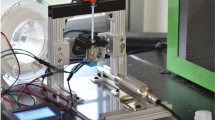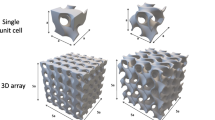Abstract
Helical tubes have been widely used in petroleum industry, but difficulties still remain in their production processes due to their unique structures. In this study, an incremental die forging process was proposed to produce helical tubes. The die structure was designed to avoid the interference between dies and workpiece when dies open. The detailed forging process was studied via finite element simulation, while an orthogonal test was conducted to investigate the effect of parameters on the shrinkage of pitch length which was defined as ∆p. It was found that the helical tube thickness t, the die pitch length p, the ratio of the sectional minor axis length in the pre-forging part to that in the finish-forging part q, and the feeding length of one reciprocation l all have significant influence on the forging process while no interaction exists among them. Besides, the influencing tendency of each parameter on ∆p is acquired through orthogonal test analysis. In the end, an optimized parameter group is obtained, with corresponding experiments conducted for validation.
Similar content being viewed by others
References
Wen T, Yang C, Zhang S, Liu L (2015) Characterization of deformation behavior of thin-walled tubes during incremental forming: a study with selected examples. Int J Adv Manuf Technol. doi:10.1007/s00170-014-6777-4
Grosman F, Madej Ł, Ziółkiewicz S, Nowak J (2012) Experimental and numerical investigation on development of new incremental forming process. J Mater Process Technol 212:2200–2209
Xu Y, Zhang SH, Li P, Yang K, Shan DB, Lu Y (2001) 3D rigid-plastic FEM numerical simulation on tube spinning. J Mater Process Technol 113:710–713
Xia Q, Cheng X, Long H, Ruan F (2012) Finite element analysis and experimental investigation on deformation mechanism of non-axisymmetric tube spinning. Int J Adv Manuf Technol 59:263–272
Zhang G, Zhang S, Li B, Zhang H (2007) Analysis on folding defects of inner grooved copper tubes during ball spin forming. J Mater Process Technol 184:393–400
Becker C, Tekkaya AE, Kleiner M (2014) Fundamentals of the incremental tube forming process. CIRP Ann Manuf Technol 63:253–256
Yang H, Li H, Zhan M (2010) Friction role in bending behaviors of thin-walled tube in rotary-draw-bending under small bending radii. J Mater Process Technol 210:2273–2284
Huang CC, Hung JC, Hung CH, Lin CR (2011) Finite element analysis on neck-spinning process of tube at elevated temperature. Int J Adv Manuf Technol 56:1039–1048
Yoshihara S, Mac Donald B, Hasegawa T, Kawahara M, Yamamoto H (2004) Design improvement of spin forming of magnesium alloy tubes using finite element. J Mater Process Technol 153–154:816–820
Ghaei A, Movahhedy MR (2007) Die design for the radial forging process using 3D FEM. J Mater Process Technol 182:534–539
Ghaei A, Movahhedy MR, KarimiTaheri A (2008) Finite element modelling simulation of radial forging of tubes without mandrel. Mater Des 29:867–872
Ameli A, Movahhedy MR (2007) A parametric study on residual stresses and forging load in cold radial forging process. Int J Adv Manuf Technol 33:7–17
Li Y, He T, Zeng Z (2013) Numerical simulation and experimental study on the tube sinking of a thin-walled copper tube with axially inner micro grooves by radial forging. J Mater Process Technol 213:987–996
Li Y, Huang J, Huang G, Wang W, Chen J, Zeng Z (2014) Comparison of radial forging between the two- and three-split dies of a thin-walled copper tube during tube sinking. Mater Des 56:822–832
Zhang Q, Jin K, Mu D, Ma P, Tian J (2014) Rotary swaging forming process of tube workpieces. Procedia Eng 81:2336–2341
Lu LS, Yuan D, Tang Y, Cheng J (2012) Slave rotation analysis of miniature inner grooved copper tube through rotary swaging process. Int J Adv Manuf Technol 61:185–193
Görtan MO, Groche P (2014) Tool design guidelines for the equal channel angular swaging (ECAS) process. J Mater Process Technol 214:2220–2232
Wang HF, Han JT, Hao QL (2015) Fabrication of laminated-metal composite tubes by multi-billet rotary swaging technique. Int J Adv Manuf Technol 76:713–719
Zhang Q, Jin K, Mu D (2014) Tube/tube joining technology by using rotary swaging forming method. J Mater Process Technol 214:2085–2094
Zhang Q, Jin KJ, Mu D, Zhang YS, Li YY (2015) Energy-controlled rotary swaging process for tube workpiece. Int J Adv Manuf Technol. doi:10.1007/s00170-015-7054-x
Kunogi M (1956) A new method of cold extrusion. J Sci Res Inst (Tokyo) 50:215–246
Sofuoglu H, Rasty J (1999) On the measurement of friction coefficient utilizing the ring compression test. Tribol Int 32:327–335
Al-Habaibeh A, Zorriassatine F, Gindy N (2002) Comprehensive experimental evaluation of a systematic approach for cost effective and rapid design of condition monitoring systems using Taguchi’s method. J Mater Process Technol 124:372–383
Sanjari M, Taheri AK, Movahedi MR (2009) An optimization method for radial forging process using ANN and Taguchi method. Int J Adv Manuf Technol 40:776–784
Pontes FJ, Paiva APD, Balestrassi PP, Ferreira JR, Silva MBD (2012) Optimization of Radial Basis Function neural network employed for prediction of surface roughness in hard turning process using Taguchi’s orthogonal arrays. Expert Syst Appl 39:7776–7787
Zhang Y, Li X, Yuan Z, Lu Y (2002) Orthogonal array design experiments for optimizing the separation of nine pesticides by micellar electrokinetic chromatography. Microchem J 73:307–315
Li J, Wang J, Zhang J, Zhou T (2010) Based on the Orthogonal Test Method Optimizing and Settings the Ant Colony Algorithm Parameters. 2010 3rd International Conference on Computer and Electrical Engineering. Singapore. doi:10.7763/ IPCSIT. 2012. V53. N0. 2.96
Bagheri H, Saraji M, Chitsazan M, Mousavi SR, Naderi M (2000) Mixed-level orthogonal array design for the optimization of solid-phase extraction of some pesticides from surface water. J Chromatogr A 888:197–208
Fang KT, Ma CX (2001) Orthogonal and uniform design of experiments. Science Press, Beijing
Author information
Authors and Affiliations
Corresponding author
Rights and permissions
About this article
Cite this article
Jin, J., Qi, Z., Wang, X. et al. An incremental die forging process for producing helical tubes. Int J Adv Manuf Technol 85, 99–114 (2016). https://doi.org/10.1007/s00170-015-7890-8
Received:
Accepted:
Published:
Issue Date:
DOI: https://doi.org/10.1007/s00170-015-7890-8




